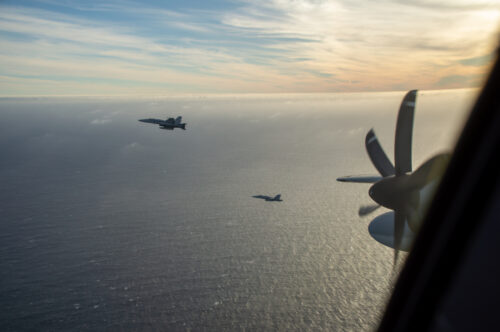Exercise UNITAS LXV, the 65th iteration of the world’s longest-running annual multinational maritime exercise, took place along the Pacific coast of South America from Sept. 2nd to 12th. Hosted by Chile, the exercise challenged participating forces with unique terrain, pushing them to adapt and refine their skills in a new environment. The United States showcased its commitment to regional stability and security through a strong presence of Marine Corps and Navy assets, including F/A-18C Hornets from Marine Fighter Attack Squadron 112 (VMFA-112), a KC-130J Hercules from Marine Aerial Refueler Transport Squadron 234 (VMGR-234), and a U.S. Navy P-8 Poseidon maritime patrol aircraft from Patrol Squadron 5.

The deployment of these aircraft from their respective bases involved extensive transcontinental flights. The Hornets and Hercules, known as the “Cowboys” and the “Rangers”, embarked on a 4,869-mile journey from Naval Air Station Joint Reserve Base Ft Worth, Texas, with a stopover in Panama before reaching Santiago. As one of the ACE planners, pilot and operations officer for VMFA 112, Maj. Anthony Heiser, stated: “It is a massive undertaking to move a squadron from Fort Worth, Texas to Santiago, Chile. Months of planning and preparation went into moving all our cargo, jets and Marines to Chile for UNITAS LXV. Once the jets and Marines arrived in Chile, the squadron was immediately ready to execute missions in support if the exercise.” Similarly, the P-8 Poseidon, flown by the “Mad Foxes”, covered 4,462 miles from Jacksonville, Florida, refueling in El Salvador en route to the exercise area. These flights underscore the logistical complexities involved in projecting military force across continents and highlight the commitment of participating nations to the exercise’s objectives.
UNITAS LXV provided a platform for the U.S. and Chilean air forces to engage in realistic mock dogfights, testing the skills of their pilots and enhancing interoperability between the two nations. The engagements involved U.S. Marine Corps F/A-18Cs and Chilean F-16 Fighting Falcons in various formats, including two-versus-two, two-versus-one, and one-versus-two scenarios. These scenarios challenged pilots to adapt their tactics, fostering a deeper understanding of each other’s capabilities and strengthening the bonds between the aircrews. Lt. Col. David Merritt, a U.S. Marine pilot who participated in these aerial engagements, commended the professionalism and airmanship of his Chilean counterparts, saying, “We had two countries training together by pitting the mastery of their aircraft against each other and sharpening each other’s skills. It was a pleasure to dogfight the commander of the FACH (Chilean Air Force) F-16 squadron today, and while we competed against each other in mock aerial combat, we departed the airspace as closer friends than before we started and with respect for each country’s capabilities.” He continued, “They demonstrated true professional airmanship with seamless integration with our own briefing, flying, and safety standards.”
Beyond air combat training, UNITAS LXV showcased the implementation of a sophisticated “targeting web” or “kill web”. This network-centric approach to warfare integrated sensors and shooters from both the U.S. and Chilean forces, demonstrating the combined capabilities of the two nations in a littoral warfare environment. The targeting web encompassed a range of assets, including the AN/TPS-80 Ground/Air Task Oriented Radar (G/ATOR) operated by U.S. Marines, F/A-18C jets, P-8 Poseidon aircraft, and the USS St. Louis (LCS 19). Each element played a crucial role in this network: the G/ATOR provided advanced multidomain sensing, the F/A-18Cs acted as potential strike platforms, the P-8 Poseidon contributed to maritime domain awareness and targeting, and the USS St. Louis represented the integration of surface assets into the targeting web.
The establishment of Expeditionary Advanced Bases (EABs) during UNITAS LXV underscored the growing importance of distributed maritime operations in modern naval warfare. A sensor EAB equipped with the G/ATOR was set up at Puerto Aldea, Chile, while a command-and-control EAB was established at the Fuerte Aguayo Chilean Marine Corps base. This distributed network enabled the identification of maritime threats and facilitated rapid decision-making regarding the deployment of appropriate assets to counter those threats. The seamless flow of information and coordination between these dispersed units highlighted the effectiveness of EABs in a littoral environment.
Underpinning the success of the targeting web and the overall effectiveness of UNITAS LXV was the LINK-16 network. This standardized tactical data transmission system, used by U.S., NATO, and coalition forces, ensured seamless communication and real-time data exchange between the participating units. LINK-16 provided a common operational picture, enhancing situational awareness and enabling coordinated action between the various elements involved in the exercise. The successful implementation of the targeting web and the smooth flow of information through LINK-16 demonstrated the interoperability of the U.S. and Chilean forces, highlighting their ability to operate effectively together in a complex and challenging environment.
For more information, hit the Source below